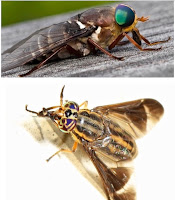With temperatures in the low 90s, Sandy keeps the horses inside the barn during the day. When their humans visit, they often get a nice hose-down while they graze. The water is always quite cold when it hits the horses, but as it drips off it’s warm and even hot. No wonder they feel so much better after a hosing.
Gus being Gus, a hose is out of the question. It was the “fsssht!” of a hose being turned on 20 feet away from him that made Gus panic so hard that he bowled me down like a ninepin. Noisy or not, squirting water gives him the willies. But I’ve managed to ply him with sponge baths — punctuated by frequent clicks and treats for standing still — which cool him down pretty well. I squeeze big gluts of water onto the insides of his upper legs, with their thin hair and big surface veins; and I damp-sponge the outsides and insides of his ludicrous ears.
For today’s bath, I practice an aspect of “natural horsemanship” on Gus. Using a small circular corral and no lead-rope, so-called horse whisperers will allow a wild or spooky horse to indulge its urge to run when afraid; in fact, they wave a scary little flag at it, so that being scared gets scarier; then, when the horse slows or looks at them, they drop the flag and relax, to ease the pressure; eventually the horse runs itself out and decides that the trainers are a refuge from the fear. It’s not super-kindly, but its lack of reliance on rope restraint does give the horse some agency. And agency is all-important to Gus.
So rather than holding Gus with one hand and squeezing the sponge with the other, I leave him at liberty. When he submits to a sploosh of the sponge, he gets a click and treat. But after three or four splooshes, the ickiness of being wet or the tickliness of being drippy is suddenly too much to bear and he stalks away to stand in the middle of the arena. I wait. He knows I have an apron full of treats. Maybe I smooch to him and pat my belly invitingly, but I stay put. In 20 seconds or so, he walks toward me, and I reward him for deciding to return. A few more spongeings, and he takes his leave again. Soon his exits just become circles as he loops right back to me. I don’t want to keep rewarding the walk-away behavior, so upon arrival now I welcome him verbally, but he gets no click-and-treat. What he does get is a chance for more spongeing, which is a chance for more rewards.
We both like this method: it’s fully voluntary for both parties, and I’m sure not to stress him too much, because he’ll walk away before that happens. The result is successful too: I rinse down not only his legs and ears, but also his back and chest and neck. When we retire to his stall for his dinner, he’s plenty soaked and happily parks himself in front of his box fan. Cool as a cucumber in the pits of summer.


